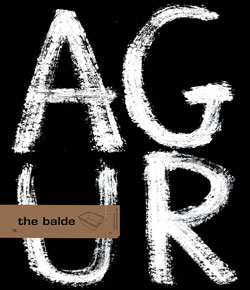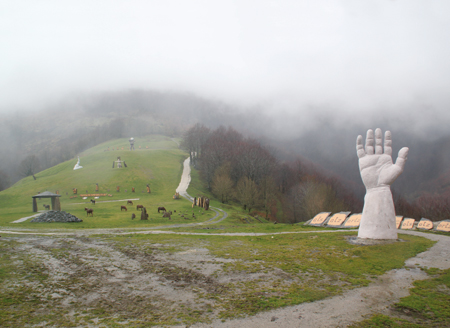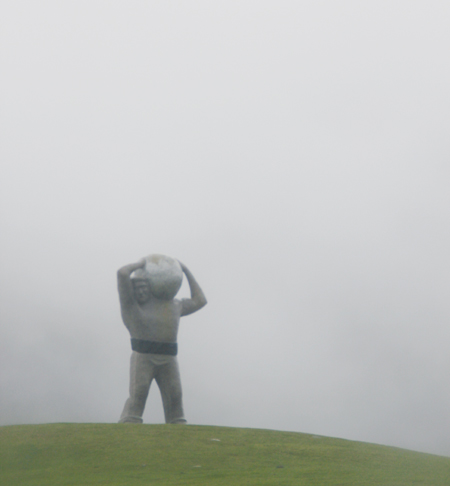peruharri the stone house text and photos by: uxeta labrit
I text and photos by: uxeta labrit You can’t miss it. By the roadside there is a two meter long hand pointing you the way to Peruharria. I came across Iñaki Perurena as I was driving up there; he was unloading a tractor with a shovel on a curve on the mountain road. Though it’s springtime, I’ve chosen a cold, rainy day to come here. He tells me to go up to the farmstead: he’ll follow me up on his tractor. Before I reach the top I start reading some slogans written on the roadside. Then I drive under a stone arch. Iñaki told me later that the arch used to be in Leitza at a place where there is now a roundabout; his father-in-law made it.
When I arrive at the farmstead, I see sculptures in the mist on the long mountainside opposite. Suddenly it seems to me that some of the sculptures are moving. They’re Pottokas (horses). It’s the way to keep the grass looking as if it’s the lawn on a mini-golf course designed by David Lynch. We go into the farmstead. He offers me a coffee, but, as we can’t get the coffee machine working, we just chat. Iñaki Perurena speaks passionately. Firstly he tells me that he never intended to make
a museum. He wants to leave a memory to stone, to the stones he’s been lifting for the last forty years, and then he and his son had the idea of making a sculpture of a stonelifter up there on the mountain. As it says in carved rock on the farmstead wall: born at heart, developed in the head and crafted with the hands.
After that first sculpture, more came along, all connected with Perurena’s special world. I can imagine what so many “necessary” experts, curators and commissioners in today’s art world would say. But there’s no need to answer to any foundation or organization here. There’s no politics. There’s no need to negotiate with any artist’s family. It’s all work done by a single person about his universe and at his home, no more than that. He’s proud to show it to anyone who cares to visit. And perhaps it’s that freedom which makes him suspicious for people from the art world. I ask him if he’s decided on his next sculpture. He does have something in mind for sure, but forty years lifting stones has left its mark on him and his health. I take a few photos before the mist covers everything. As I drive down the mountain, the stonelifter appears in my rear-view mirror, held
up in the air, in the white mist...
When I arrive at the farmstead, I see sculptures in the mist on the long mountainside opposite. Suddenly it seems to me that some of the sculptures are moving. They’re Pottokas (horses). It’s the way to keep the grass looking as if it’s the lawn on a mini-golf course designed by David Lynch. We go into the farmstead. He offers me a coffee, but, as we can’t get the coffee machine working, we just chat. Iñaki Perurena speaks passionately. Firstly he tells me that he never intended to make
a museum. He wants to leave a memory to stone, to the stones he’s been lifting for the last forty years, and then he and his son had the idea of making a sculpture of a stonelifter up there on the mountain. As it says in carved rock on the farmstead wall: born at heart, developed in the head and crafted with the hands.
After that first sculpture, more came along, all connected with Perurena’s special world. I can imagine what so many “necessary” experts, curators and commissioners in today’s art world would say. But there’s no need to answer to any foundation or organization here. There’s no politics. There’s no need to negotiate with any artist’s family. It’s all work done by a single person about his universe and at his home, no more than that. He’s proud to show it to anyone who cares to visit. And perhaps it’s that freedom which makes him suspicious for people from the art world. I ask him if he’s decided on his next sculpture. He does have something in mind for sure, but forty years lifting stones has left its mark on him and his health. I take a few photos before the mist covers everything. As I drive down the mountain, the stonelifter appears in my rear-view mirror, held
up in the air, in the white mist...




